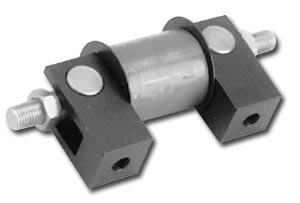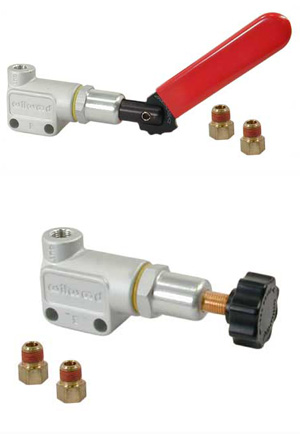www.mumboracing.com
Biased Opinion
Racing is about getting the maximum speed out of the car to achieve the minimum laptime. In circuit racing, we go around corners, and to ensure we can go as fast as possible for as long as possible, and still negotiate the next corner, braking is critical.
To achieve optimum braking, we need to apply the right amount of braking force through each of our tyres. Too much force and the tyre will lock, reducing braking efficiency, too little force and we will either not make the corner, or need to commence braking too early. This situation is complicated further by the transfer of weight as the braking force is applied, giving our front tyres more grip than the rear tyres, and offering more braking potential through the front tyres than the rears.
Most race cars will feature some method of brake bias adjustment to vary the ratio between front and rear braking force (some very advanced setups, previously seen in F1, dynamically varied the force side-to-side aswell, but that is well beyond the scope of this article!). This article will outline two methods of adjusting brake bias to achieve that optimum ratio.
Systems:
There are two main types of bias adjustment. The most common, and preferred method is to adjust a balance bar within the pivot of the brake pedal, varying the ratio of force between the front and rear brake master cylinders.

A small knob is usually mounted on the dashboard. Rotating the knob rotates the cable, which in turn rotates the threaded rod. As the threaded rod rotates, the pivot point moves toward the front or rear master cylinder, varying the proportion of force applied.
The alternative system, which offers a slightly more coarse adjustment (and is somewhat more prone to hysteresis and unreliability) is the proportioning valve. Usually mounted in the rear brake line, the valve limits the flow of fluid between the rear master cylinder and the rear brakes, effectively adjusting the ratio of front to rear force by reducing the force at the rear.

There are two main variants - the lever type, which offers fast, coarse adjustment, and the knob type, which offers slower, more fine adjustment.
Techniques:
There are two techniques to setting the brake bias. Both can be used with either of the systems outlined above.
Method #1
The first method can be done in the workshop, before even arriving at the circuit. This is a 'ballpark' type setting, and should usually be refined by using the second method on-track. If done correctly though, the initial setting will usually be within a turn or so of the ideal setting.
Fit wheels and tyres to the racecar, ensure the brakes are free of oil, corrosion or any other friction reducing problems. Place the car on stands and have a helper in the driver's seat. The helper must be reliable and able to maintain a set brake pedal pressure.
Position yourself so you can rotate the front wheels by hand. Start rotating the wheel (slowly is fine) by hand, and have the helper slowly press the brake pedal. Once your helper reaches a pedal pressure where you can no longer rotate the front wheels, have him/her hold that pedal pressure. Move to the rear wheels and attempt to rotate by hand. If the bias is set correctly, you should just barely be able to rotate the rear wheels.
If you can rotate the rear wheels freely, adjust the bias towards the rear and repeat the test. If you are unable to rotate the rear wheels, adjust the bias towards the front and repeat the test. Continue repeating until you can just barely rotate the rear wheels when the front wheels are locked.
Method #2
This method is more accurate, but requires excellent driver feel, and preferably an outside observer. It also requires a racetrack or other safe operating area.
Warm the car up, and drive at moderate pace toward the test (braking) area. Apply the brakes normally, until either the front or rear wheels are felt to lock. Use the feedback of the outside observer to confirm which wheels locked (if all four locked, you need to repeat the test, or you bias may already be perfect). Adjust the bias away from the end that locked. Repeat the test. Repeat until under normal braking, as force is increased, all four wheels lock at the same time. It is important to note that 'panic' or unusually rapid braking is of no benefit for this test, as the car needs to be in a normal braking state (stabilised with weight transfer at or near where it will be under normal, race braking).
Other Notes:
Further fine tuning should be done under practice/race conditions. It can sometimes be beneficial to have a slight bias to one end or the other, for example and understeering car may respond well to a slightly more rearward bias, effectively overloading the rear tyres and allowing some rotation of the car on the brakes to compensate for the lack of front grip ('backing it in'). A slight bias towards the front is a more stable, and beginner driver friendly state, as it gives more warning that the limit is being reached.
Further Reading:
Read Carroll Smith's books. Tune to Win and Drive to Win are probably most relevant to this topic, but all of his books are invaluable.
Disclaimer:
Remember, you are responsible for the consequences of any changes you make, and any adverse outcomes. This article is provided for reference only. Neither iRace or the author offer any warranty or any liability for any damage or injury caused by tweaking any racecar.
To achieve optimum braking, we need to apply the right amount of braking force through each of our tyres. Too much force and the tyre will lock, reducing braking efficiency, too little force and we will either not make the corner, or need to commence braking too early. This situation is complicated further by the transfer of weight as the braking force is applied, giving our front tyres more grip than the rear tyres, and offering more braking potential through the front tyres than the rears.
Most race cars will feature some method of brake bias adjustment to vary the ratio between front and rear braking force (some very advanced setups, previously seen in F1, dynamically varied the force side-to-side aswell, but that is well beyond the scope of this article!). This article will outline two methods of adjusting brake bias to achieve that optimum ratio.
The goal is always when braking at maximum capacity that an increase in braking force will cause the front and rear tyres to lock simultaneously.
Systems:
There are two main types of bias adjustment. The most common, and preferred method is to adjust a balance bar within the pivot of the brake pedal, varying the ratio of force between the front and rear brake master cylinders.

A small knob is usually mounted on the dashboard. Rotating the knob rotates the cable, which in turn rotates the threaded rod. As the threaded rod rotates, the pivot point moves toward the front or rear master cylinder, varying the proportion of force applied.
The alternative system, which offers a slightly more coarse adjustment (and is somewhat more prone to hysteresis and unreliability) is the proportioning valve. Usually mounted in the rear brake line, the valve limits the flow of fluid between the rear master cylinder and the rear brakes, effectively adjusting the ratio of front to rear force by reducing the force at the rear.

There are two main variants - the lever type, which offers fast, coarse adjustment, and the knob type, which offers slower, more fine adjustment.
Techniques:
There are two techniques to setting the brake bias. Both can be used with either of the systems outlined above.
Method #1
The first method can be done in the workshop, before even arriving at the circuit. This is a 'ballpark' type setting, and should usually be refined by using the second method on-track. If done correctly though, the initial setting will usually be within a turn or so of the ideal setting.
Fit wheels and tyres to the racecar, ensure the brakes are free of oil, corrosion or any other friction reducing problems. Place the car on stands and have a helper in the driver's seat. The helper must be reliable and able to maintain a set brake pedal pressure.
Position yourself so you can rotate the front wheels by hand. Start rotating the wheel (slowly is fine) by hand, and have the helper slowly press the brake pedal. Once your helper reaches a pedal pressure where you can no longer rotate the front wheels, have him/her hold that pedal pressure. Move to the rear wheels and attempt to rotate by hand. If the bias is set correctly, you should just barely be able to rotate the rear wheels.
If you can rotate the rear wheels freely, adjust the bias towards the rear and repeat the test. If you are unable to rotate the rear wheels, adjust the bias towards the front and repeat the test. Continue repeating until you can just barely rotate the rear wheels when the front wheels are locked.
Method #2
This method is more accurate, but requires excellent driver feel, and preferably an outside observer. It also requires a racetrack or other safe operating area.
Warm the car up, and drive at moderate pace toward the test (braking) area. Apply the brakes normally, until either the front or rear wheels are felt to lock. Use the feedback of the outside observer to confirm which wheels locked (if all four locked, you need to repeat the test, or you bias may already be perfect). Adjust the bias away from the end that locked. Repeat the test. Repeat until under normal braking, as force is increased, all four wheels lock at the same time. It is important to note that 'panic' or unusually rapid braking is of no benefit for this test, as the car needs to be in a normal braking state (stabilised with weight transfer at or near where it will be under normal, race braking).
Other Notes:
Further fine tuning should be done under practice/race conditions. It can sometimes be beneficial to have a slight bias to one end or the other, for example and understeering car may respond well to a slightly more rearward bias, effectively overloading the rear tyres and allowing some rotation of the car on the brakes to compensate for the lack of front grip ('backing it in'). A slight bias towards the front is a more stable, and beginner driver friendly state, as it gives more warning that the limit is being reached.
Further Reading:
Read Carroll Smith's books. Tune to Win and Drive to Win are probably most relevant to this topic, but all of his books are invaluable.
Disclaimer:
Remember, you are responsible for the consequences of any changes you make, and any adverse outcomes. This article is provided for reference only. Neither iRace or the author offer any warranty or any liability for any damage or injury caused by tweaking any racecar.